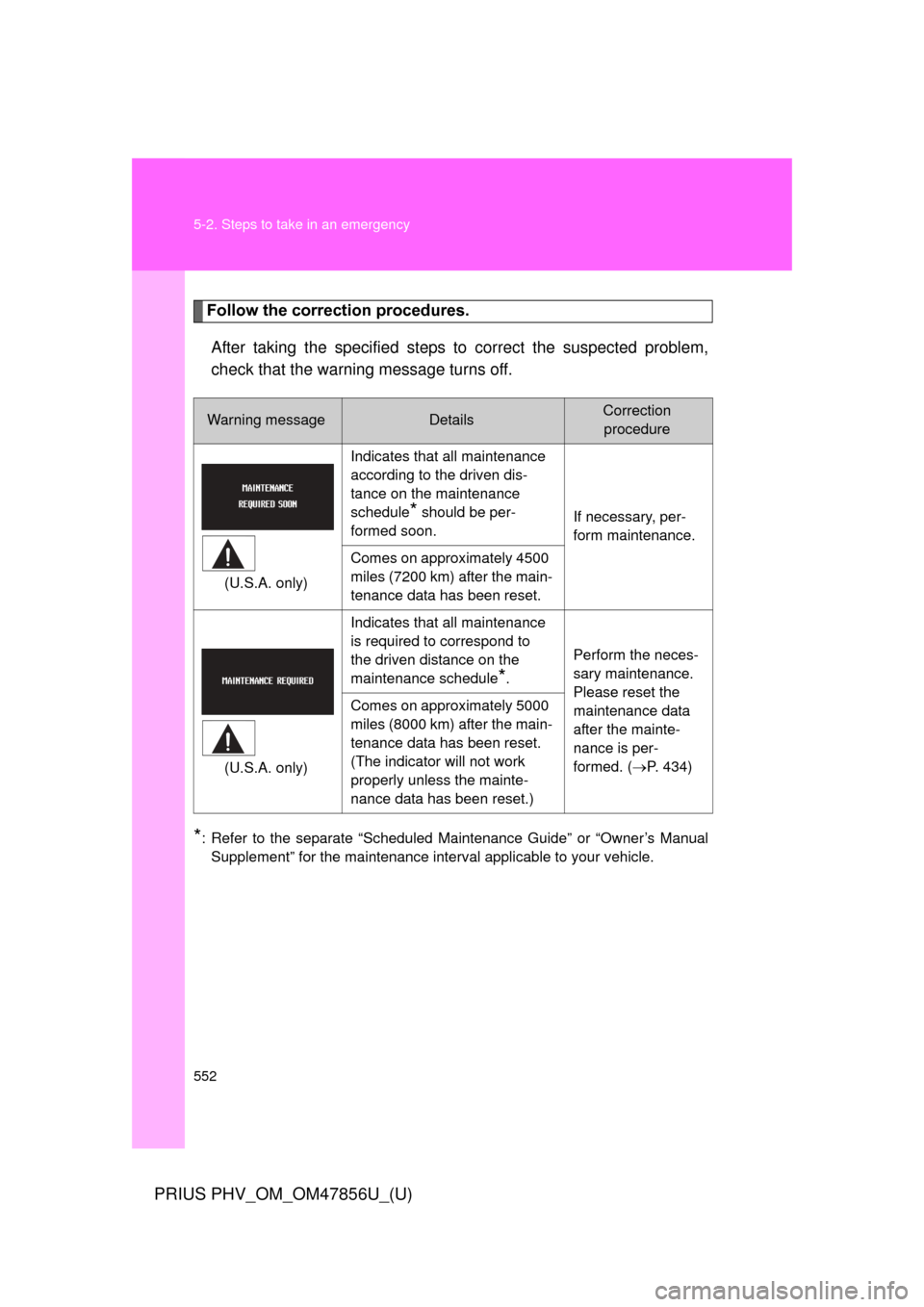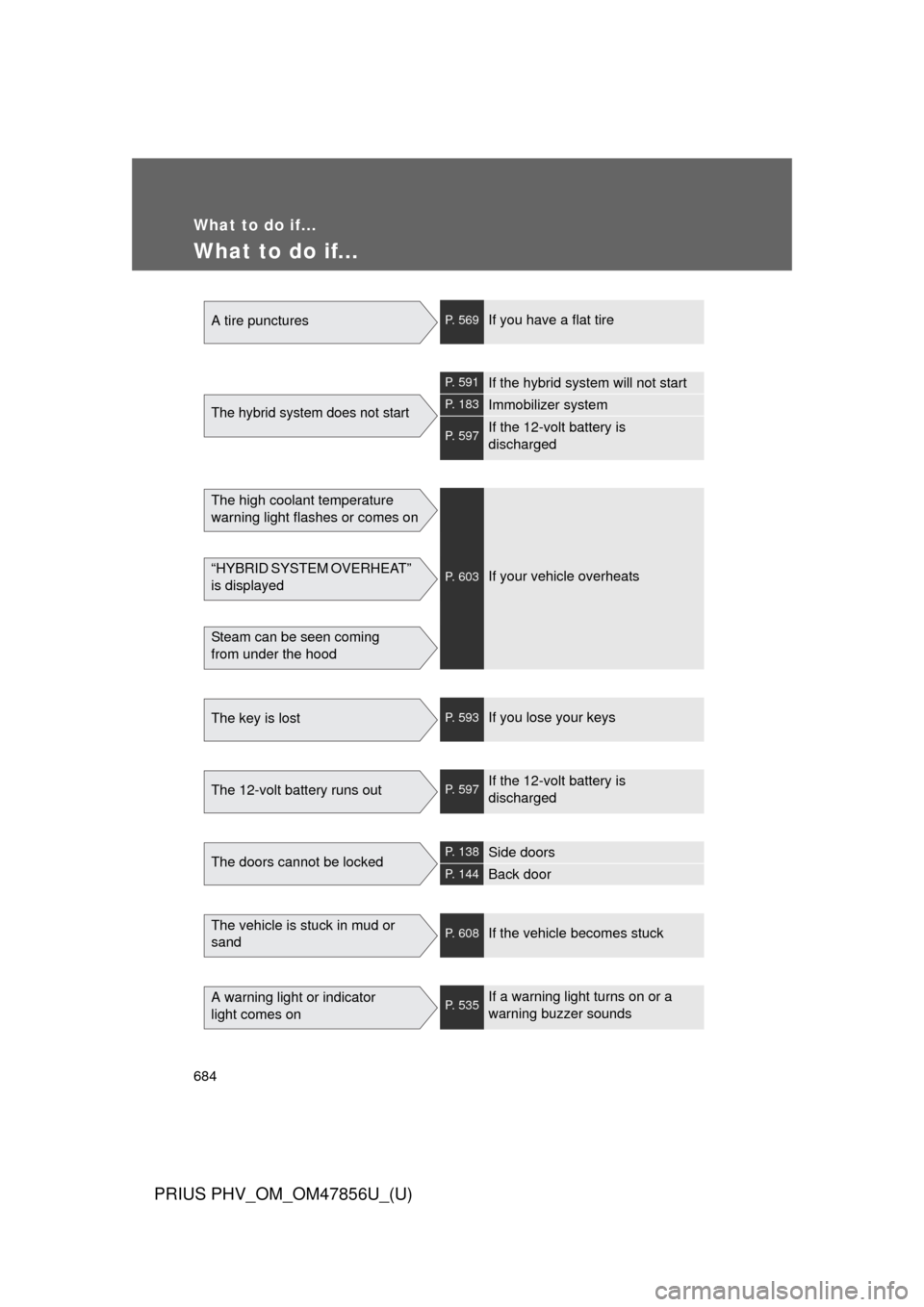2014 TOYOTA PRIUS PLUG-IN HYBRID ESP
[x] Cancel search: ESPPage 486 of 688

486 4-3. Do-it-yourself maintenance
PRIUS PHV_OM_OM47856U_(U)
■Tire pressure warning system certification
For vehicles sold in the U.S.A.
MODEL/FCC IDs:
Transmitter: PAXPMV107J
Receiver: HYQ13BDE
NOTE:
This device complies with part 15 of the FCC Rules. Operation is subject
to the following two conditions: (1) This device may not cause harmful
interference, and (2) this device must accept any interference received,
including interference that may cause undesired operation.
FCC WARNING:
Changes or modifications not expre ssly approved by the party responsi-
ble for compliance could void the user’s authority to operate the equip-
ment.
For vehicles sold in Canada
Operation is subject to the following two conditions; (1) this device may
not cause interference, and (2) this de vice must accept any interference,
including interference that may caus e undesired operation of the device.
Page 546 of 688

546 5-2. Steps to take in an emergency
PRIUS PHV_OM_OM47856U_(U)
CAUTION
As an added safety feature, your vehicle has been equipped with a tire
pressure monitoring system (TPMS-ti re pressure warning system) that
illuminates a low tire pressure telltal e (tire pressure warning light) when
one or more of your tires is significantly under-inflated. Accordingly,
when the low tire pressu re telltale (tire pressure warning light) illumi-
nates, you should stop and check your tires as soon as possible, and
inflate them to the proper pressure. Driving on a significantly under-
inflated tire causes the tire to overheat and can lead to tire failure.
Under-inflation also reduces fuel effi ciency and tire tread life, and may
affect the vehicle’s handling and stopping ability.
Please note that the TPMS (tire pressure warning system) is not a sub-
stitute for proper tire main tenance, and it is the driver’s responsibility to
maintain correct tire pressure, even if under-inflation has not reached the
level to trigger illu mination of the TPMS low tire pressure telltale (tire
pressure warning light).
Your vehicle has also been equipped with a TPMS (tire pressure warning
system) malfunction indicator to indi cate when the system is not operat-
ing properly. The TPMS (tire pressure warning system) malfunction indi-
cator is combined with the low tire pressure telltale (tire pressure
warning light). When the system det ects a malfunction, the telltale will
flash for approximately one minute an d then remain continuously illumi-
nated. This sequence will continue upon subsequent vehicle start-ups as
long as the malfunction exists. When the malfunction indi cator is illumi-
nated, the system may not be able to detect or signal low tire pressure
as intended.
Page 552 of 688

552 5-2. Steps to take in an emergency
PRIUS PHV_OM_OM47856U_(U)
Follow the correction procedures.After taking the specified steps to correct the suspected problem,
check that the warning message turns off.
*: Refer to the separate “Scheduled Maintenance Guide” or “Owner’s Manual Supplement” for the maintenance interval applicable to your vehicle.
Warning messageDetailsCorrection procedure
(U.S.A. only) Indicates that all maintenance
according to the driven dis-
tance on the maintenance
schedule
* should be per-
formed soon. If necessary, per-
form maintenance.
Comes on approximately 4500
miles (7200 km) after the main-
tenance data has been reset.
(U.S.A. only) Indicates that all maintenance
is required to correspond to
the driven distance on the
maintenance schedule
*.
Perform the neces-
sary maintenance.
Please reset the
maintenance data
after the mainte-
nance is per-
formed. (
P. 434)
Comes on approximately 5000
miles (8000 km) after the main-
tenance data has been reset.
(The indicator will not work
properly unless the mainte-
nance data has been reset.)
Page 586 of 688

586 5-2. Steps to take in an emergency
PRIUS PHV_OM_OM47856U_(U)
■Emergency tire puncture repair kit
●The sealant stored in the emergency tire puncture repair kit can be
used only once to temporarily repair a single tire. If the sealant has
been used and needs to be purchased, contact your Toyota dealer.
●The sealant can be used when the outside temperature is from -40°F
(-40°C) to 140°F (60°C).
●The repair kit is exclusively designed for size and type of tires origi-
nally installed on your vehicle. Do not use it for tires that a different
size than the original ones, or for any other purposes.
●The sealant has a limited lifespan. T he expiry date is shown on the
bottle. The sealant should be replaced before the expiry date. Con-
tact your Toyota dealer.
●If the sealant gets on your clothes, it may stain.
●If the sealant adheres to a wheel or the surface of the vehicle body,
the stain may not be removable if it is not cleaned at once. Immedi-
ately wipe away the sealant with a wet cloth.
●During operation of the repair kit, a loud operation noise is produced.
This does not indicate a malfunction.
●Do not use to check or to adjust the tire pressure.
Page 589 of 688

5
When trouble arises
589
5-2. Steps to take in an emergency
PRIUS PHV_OM_OM47856U_(U)
CAUTION
●The repair kit may overheat if operated for a long period of time. Do not
operate the repair kit continuously for more than 60 minutes.
●Parts of the repair kit become hot during operation. Be careful handling
the repair kit during and after operation. Do not touch the metal part
connecting the bottle and the co
mpressor. It will be extremely hot.
●Do not attach the vehicle speed warning sticker to an area other than
the one indicated. If the sticker is attached to an area where an SRS
airbag is located, such as the pad of the steering wheel, it may prevent
the SRS airbag from operating properly.
■Driving to spread the liquid sealant evenly
Observe the following precautions to reduce the risk of accidents.
Failing to do so may result in a loss of vehicle control and cause death or
serious injury.
●Drive the vehicle carefully at a lo w speed. Be especially careful when
turning and cornering.
●If the vehicle does not drive straight or you feel a pull through the
steering wheel, stop the vehicle and check the following.
• Tire condition. The tire may have separated from the wheel.
• Tire inflation pressure. If the tire inflation pressure is 19 psi (130 kPa, 1.3 kgf/cm
2 or bar) or less, the tire may be severely damaged.
Page 607 of 688

5
When trouble arises
607
5-2. Steps to take in an emergency
PRIUS PHV_OM_OM47856U_(U)
CAUTION
■
To prevent an accident or injury when inspecting under the hood of
your vehicle
●If steam is seen coming from under the hood, do not open the hood until
the steam has subsided. The engine compartment may be very hot, caus-
ing serious injuries such as burns.
● After the hybrid system has been turned off, check that the indicator on the
“POWER” switch and the “READY” indicator are off.
When the hybrid system is operating, the gasoline engine may automati-
cally start, or the cooling fans may suddenly operate even if the gasoline
engine stops. Do not touch or approach rotating parts such as the fans,
which may lead to fingers or clothing (especially a tie, a scarf or a muffler)
getting caught, resulting in serious injury.
● Do not loosen the coolant reservoir cap while the hybrid system and radia-
tor are hot.
Serious injury, such as burns, may result from hot coolant and steam
released under pressure.
NOTICE
■When adding engine/power control unit coolant
Wait until the hybrid system has cooled down before adding engine/power
control unit coolant.
When adding coolant, do so slowly. Adding cool coolant to a hot hybrid sys-
tem too quickly can cause damage to the hybrid system.
■ To prevent damage to the cooling system
Observe the following precautions:
●Avoid contaminating the coolant with foreign matter (such as sand or dust
etc.).
● Do not use any coolant additives.
Page 634 of 688

634 6-1. Specifications
PRIUS PHV_OM_OM47856U_(U)
■Traction AA, A, B, C
The traction grades, from highest to lowest, are AA, A, B and C,
and they represent the tire’s ab ility to stop on wet pavement as
measured under controlled cond itions on specified government
test surfaces of asphalt and concrete.
A tire marked C may have poor traction performance.
Warning: The traction grade assigned to this tire is based on braking
(straight ahead) traction tests and does not include cornering (turn-
ing) traction.
■ Temperature A, B, C
The temperature grades are A (the highest), B, and C, represent-
ing the tire’s resistance to the generation of heat and its ability to
dissipate heat when tested under controlled conditions on a speci-
fied indoor laboratory test wheel.
Sustained high temperature can cause the material of the tire to
degenerate and reduce tire life, and excessive temperature can lead
to sudden tire failure.
Grade C corresponds to a level of performance which all passenger
car tires must meet under the Federal Motor Vehicle Safety Standard
No. 109.
Grades B and A represent higher levels of performance on the labo-
ratory test wheel than the minimum required by law.
Warning: The temperature grades of a tire assume that it is properly
inflated and not overloaded.
Excessive speed, underinflation, or excessive loading, either sepa-
rately or in combination, can cause heat buildup and possible tire fail-
ure.
Page 684 of 688

684
PRIUS PHV_OM_OM47856U_(U)
What to do if...
What to do if...
A tire puncturesP. 569If you have a flat tire
The hybrid system does not start
P. 591If the hybrid system will not start
P. 183Immobilizer system
P. 597If the 12-volt battery is
discharged
The high coolant temperature
warning light flashes or comes on
“HYBRID SYSTEM OVERHEAT”
is displayed
Steam can be seen coming
from under the hood
P. 603If your vehicle overheats
The key is lostP. 593If you lose your keys
The 12-volt battery runs outP. 597If the 12-volt battery is
discharged
The doors cannot be lockedP. 138Side doors
P. 144Back door
The vehicle is stuck in mud or
sandP. 608If the vehicle becomes stuck
A warning light or indicator
light comes onP. 535If a warning light turns on or a
warning buzzer sounds